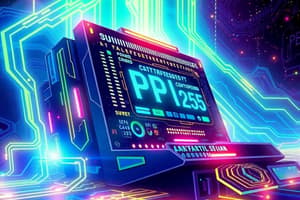Podcast
Questions and Answers
What is the purpose of the handshaking signals in MODE 1 of the 8255A?
What is the purpose of the handshaking signals in MODE 1 of the 8255A?
- To transfer data between ports with the same data transfer rate
- To synchronize the data transfer between the 8255A and the external device (correct)
- To set or reset individual bits in port C
- To allow for bidirectional data transfer on a single data bus
Which mode of the 8255A allows for bidirectional data transfer on a single 8-bit data bus?
Which mode of the 8255A allows for bidirectional data transfer on a single 8-bit data bus?
- BSR (Bit Set/Reset) Mode
- MODE 0
- MODE 2 (correct)
- MODE 1
In the I/O (Input/Output) MODE 0 of the 8255A, how are the input and output ports configured?
In the I/O (Input/Output) MODE 0 of the 8255A, how are the input and output ports configured?
- Port A and Port B are configurable as input or output, while Port C is fixed as input
- All ports are fixed as either input or output
- All ports are configurable as either input or output (correct)
- Port A and Port B are fixed as input, while Port C is configurable as input or output
What is the purpose of the Bit Set/Reset (BSR) mode of the 8255A control word?
What is the purpose of the Bit Set/Reset (BSR) mode of the 8255A control word?
In MODE 1 of the 8255A, which ports can be used for input or output with handshaking signals?
In MODE 1 of the 8255A, which ports can be used for input or output with handshaking signals?
Which mode of the 8255A allows for the most flexible input/output configuration?
Which mode of the 8255A allows for the most flexible input/output configuration?
In the handshake mode for Port A of the 8155, which signals from Port C are used as control signals?
In the handshake mode for Port A of the 8155, which signals from Port C are used as control signals?
What is the purpose of the STB (Strobe) signal in the handshake mode?
What is the purpose of the STB (Strobe) signal in the handshake mode?
In the status word format of the 8155, which bit position represents the Timer flag?
In the status word format of the 8155, which bit position represents the Timer flag?
What is the purpose of the INTE (Interrupt Enable) bit in the status word format?
What is the purpose of the INTE (Interrupt Enable) bit in the status word format?
In the given example of interfacing design using the 8155, which signal from Port C is used for the Start of Conversion (SOC) signal?
In the given example of interfacing design using the 8155, which signal from Port C is used for the Start of Conversion (SOC) signal?
What is the purpose of the decoder in the given example of interfacing design using the 8155?
What is the purpose of the decoder in the given example of interfacing design using the 8155?
In Mode 1 of the 8255A PPI, which control signals are used for Port A when configured as an input port?
In Mode 1 of the 8255A PPI, which control signals are used for Port A when configured as an input port?
What is the function of the IBF (Input Buffer Full) signal in Mode 1?
What is the function of the IBF (Input Buffer Full) signal in Mode 1?
In the control word format for Mode 2, what do the D4 and D3 bits represent?
In the control word format for Mode 2, what do the D4 and D3 bits represent?
Which lines of Port C are used as handshake signals for Port B when configured in Mode 1, regardless of whether Port B is an input or output port?
Which lines of Port C are used as handshake signals for Port B when configured in Mode 1, regardless of whether Port B is an input or output port?
What is the purpose of the INTE (Interrupt Enable) signal in Mode 1?
What is the purpose of the INTE (Interrupt Enable) signal in Mode 1?
In the status word format for Mode 2, what does the OBF A bit represent?
In the status word format for Mode 2, what does the OBF A bit represent?
Flashcards are hidden until you start studying





